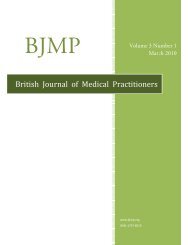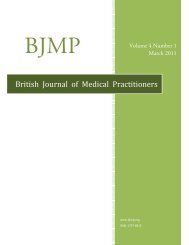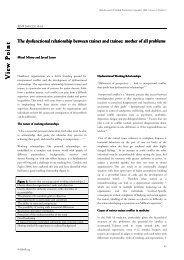R esearch A rticle - British Journal of Medical Practitioners
R esearch A rticle - British Journal of Medical Practitioners
R esearch A rticle - British Journal of Medical Practitioners
You also want an ePaper? Increase the reach of your titles
YUMPU automatically turns print PDFs into web optimized ePapers that Google loves.
<strong>British</strong> <strong>Journal</strong> <strong>of</strong> <strong>Medical</strong> <strong>Practitioners</strong>, March 2013, Volume 6, Number 1<br />
leading to excessive glutaminergic signalling and increased<br />
electrical activity in neurons. As glutamate is the primary<br />
excitatory neurotransmitter <strong>of</strong> the central nervous system,<br />
stabilizing or reducing glutaminergic activity could prove useful<br />
in the treatment <strong>of</strong> IEED. 39<br />
Treatment<br />
Medication options include the use <strong>of</strong> SSRIs, tricyclic<br />
antidepressants (TCAs) for example, amitriptyline, and less<br />
frequently dopaminergic agents.A combination <strong>of</strong><br />
35 38<br />
dextromethorphan and quinidine has also been suggested.<br />
Sleep disorders<br />
Epidemiology<br />
Sleep disorders have been known to affect 60-98% <strong>of</strong> patients<br />
with PD. 40<br />
Aetiology and risk factors<br />
The aetiology <strong>of</strong> sleep disorders includes PD itself or other<br />
comorbid conditions such as depression, and cognitive<br />
impairment. 41 Nocturnal pain from rigidity or dystonia, restless<br />
legs syndrome, and autonomic disturbance leading to nocturnal<br />
frequency and urgency, also contribute to insomnia.<br />
Degeneration <strong>of</strong> sleep regulatory centres in the brainstem and<br />
thalamocortical pathways, side effects <strong>of</strong> drugs, motor<br />
impairment, and incontinence may affect sleep. Sleep disorders<br />
may precede the onset <strong>of</strong> motor symptoms. Rapid Eye<br />
Movement (REM) sleep behaviour disorder (RBD), which<br />
occurs in almost a third <strong>of</strong> PD patients, is <strong>of</strong>ten associated with<br />
cognitive impairment and hallucinations. This disorder is<br />
directly related to the degenerative process <strong>of</strong> the<br />
pedunculopontine nucleus, the locus subceruleus and the<br />
retrorubral nucleus. A sudden onset <strong>of</strong> the disorder is almost<br />
always due to the introduction or the withdrawal <strong>of</strong> drugs,<br />
especially antidepressants. Curiously, parkinsonism can<br />
disappear during the RBD. 42<br />
Sleep fragmentation is the earliest and most common sleep<br />
disorder in PD, and gradually worsens as the disease progresses.<br />
Vivid dreaming, nightmares and night terrors are common and<br />
occur in up to 30% <strong>of</strong> patients using levodopa for long periods.<br />
Dream content is probably altered in PD and many patients<br />
vocalize during sleep. Vocalization may vary from<br />
incomprehensible sounds to detailed conversations, laughing,<br />
cursing or screaming. Excessive daytime sleepiness and 'sleep<br />
attacks' affect half <strong>of</strong> patients with PD and may precede disease<br />
onset. The causes are a combination <strong>of</strong> the disease process, the<br />
consequence <strong>of</strong> other sleep disorders and medication. A sudden<br />
onset <strong>of</strong> sleep during the day is a phenomenon in PD which<br />
resembles narcolepsy, and it is commonly associated with<br />
dopaminergic drugs. PD patients may be more prone to restless<br />
legs syndrome, periodic limb movements and obstructive sleep<br />
apnoea.<br />
Sleep disorders in PD are seldom diagnosed and treated.<br />
Although an accurate diagnosis <strong>of</strong> a particular sleep disorder<br />
depends on polysomnography, sometimes the diagnosis can be<br />
based on clinical observation. Treatment is based on the correct<br />
diagnosis and underlying cause <strong>of</strong> the sleep disorder. Often it is<br />
difficult to decide whether excessive daytime sleepiness is cause<br />
or consequence <strong>of</strong> insomnia. 43<br />
Presentation and diagnosis<br />
Sleep disorders may manifest as insomnia, excessive daytime<br />
sleepiness and sleepwalking. 44, 45 Sudden attacks <strong>of</strong> sleepiness are<br />
known to occur during stimulating activities such as walking,<br />
eating, and even driving a car. These sudden sleep episodes can<br />
be associated with medication such as dopamine agonists and<br />
levodopa. 46<br />
RBD is characterised by the loss <strong>of</strong> the normal atonia during<br />
dreaming. In other words, patients act out their dreams as<br />
manifested by crying out, kicking or thrashing about during<br />
their sleep. RBD can predate the development <strong>of</strong> motor<br />
symptoms by several years and a longitudinal study <strong>of</strong> a cohort<br />
<strong>of</strong> 26 patients found an association between RBD and the later<br />
development <strong>of</strong> PD. 47<br />
Treatment<br />
Management involves the review <strong>of</strong> medication that may be<br />
contributing to the sleep disorder. Treatment <strong>of</strong> comorbid<br />
conditions such as depression and cognitive impairment is<br />
essential.<br />
Sleep hygiene is the initial and basic measure applied to all<br />
patients. For instance, stimulating patients during the day can<br />
decrease the excessive naps and improve sleep at night, thus<br />
improving daytime sleepiness. Additional techniques include<br />
going to bed only when sleepy, exposure to natural and bright<br />
light during day, reduction <strong>of</strong> light and noise exposure at night<br />
as much as possible, and maintenance <strong>of</strong> a regular schedule.<br />
Long-acting dopaminergic drugs might improve insomnia<br />
caused by worsening <strong>of</strong> motor symptoms at night. Clonazepam,<br />
a benzodiazepine, is efficacious and well tolerated by the<br />
majority <strong>of</strong> patients afflicted by RBD and should be considered<br />
as initial treatment. 48 Antidepressants with a sedative effect<br />
might be helpful in cases <strong>of</strong> insomnia with comorbid depression<br />
or anxiety. Quetiapine, an antipsychotic which has sedative<br />
properties as a side effect, may be a safe and effective treatment<br />
for insomnia in PD because it has no untoward effects on<br />
motor function. 49 Small clinical trials with Modafinil for<br />
excessive daytime sleepiness had controversial results. An<br />
additional remark concerning treatment <strong>of</strong> sleep disorder in PD<br />
is that sleep may provide a short-term benefit on motor<br />
symptoms. 28, 43 26<br />
BJMP.org







